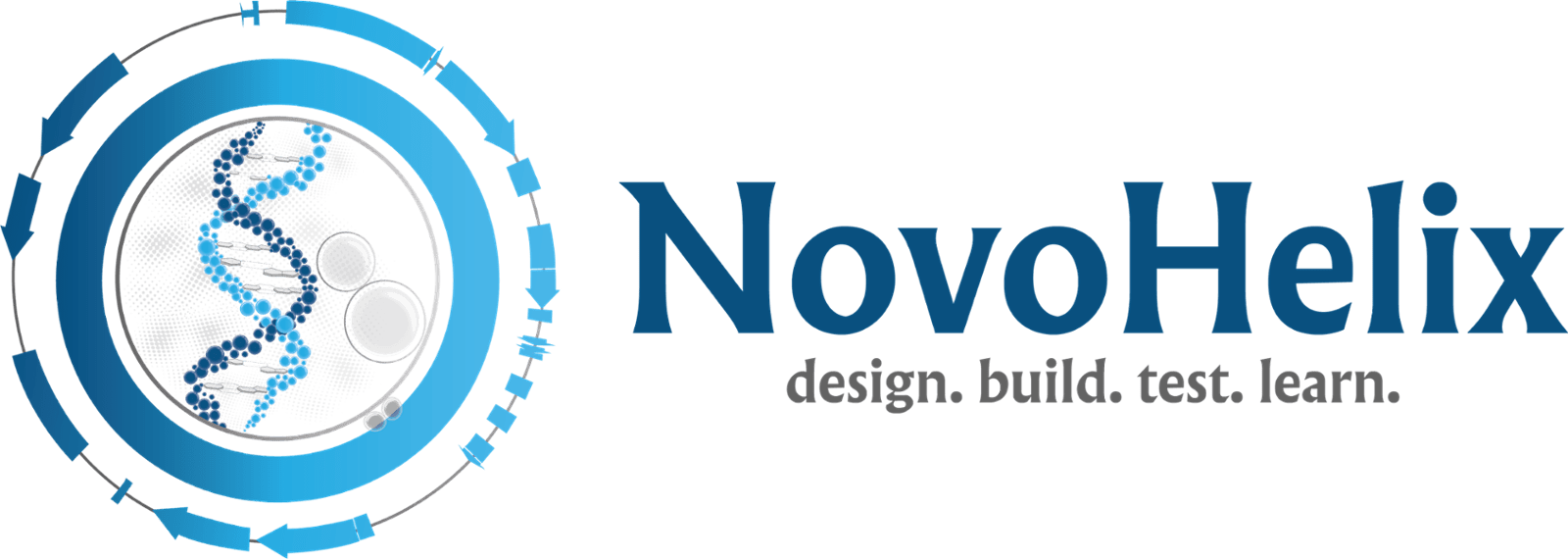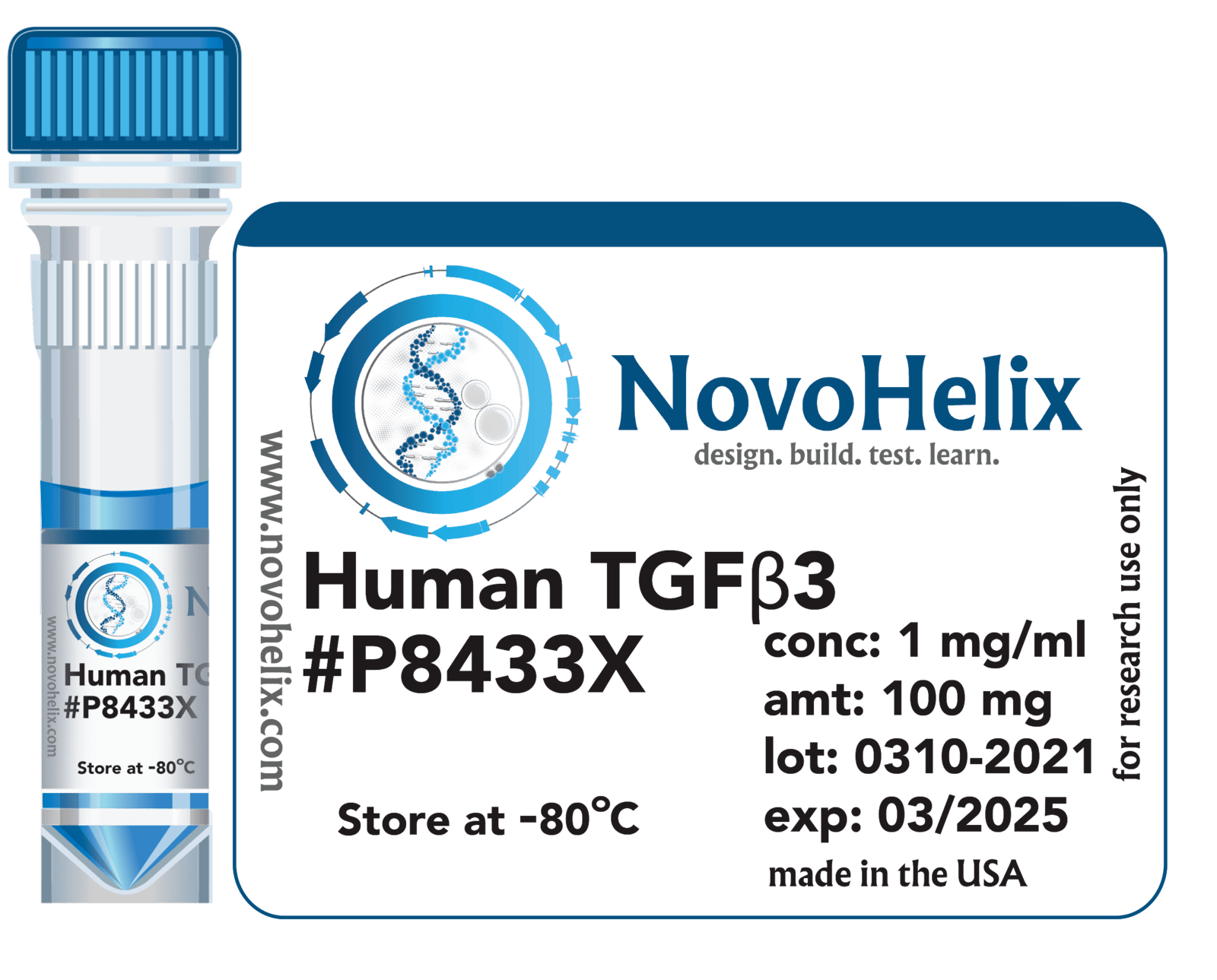TGFβ3 —Transforming Growth Factor-β3
Product
Catalog Nr
Size
Concentration
Pricing
Human TGFβ3
P8433B
bulk
Want to try this product? Request a sample of TGFβ3 —Transforming Growth Factor-β3.
Product Information
Product Literature & Protocol
FAQs & Troubleshooting
References
Supporting Documents
Product Information
Source:
Human TGFβ3 was improved through protein engineering efforts. The final engineered protein was synthesized as a codon-optimized minigene, was expressed heterologously in an E. coli strain with the assistance of chaperone proteins and was purified by proprietary chromatographic techniques. This product is manufactured in the USA using chemically-defined components and, therefore, does not contain manufacturing components such as serum or animal-derived raw materials. The recombinant protein was tested and normalized to standard activity assays for growth of human pluripotent stem cells.
Molecular Weight:
12.9 kDa monomer; 25.7 kDa dimer
Purity:
>98 % by SDS-PAGE and analysis by protein mass spectrometry
Sequence Analysis:
Purified recombinant protein was subjected to peptide mass fingerprinting (PMF) by MALDI-TOF/TOF (PMF + MS/MS).
Cross Reactivity:
Human, rhesus, cynomolgus/cercopithecine, mouse/murine, rat/murine, pig/porcine, cow/bovine, goat/caprine, dog/canine, cat/feline, horse/equine
Biological Activity:
Proliferation of a human pluripotent stem cell (hPSC) line cultured under 5% oxygen tension & 5% CO2 on a recombinant laminin 521 matrix with a serum-free DMEM/F12 standard basal media containing FGF2, TGFβ3, transferrin, vitamin C (L-ascorbic acid-2-phosphate), NRG1 (neuregulin-1β), LR3-IGF1 and recombinant 0.1% HSA. TGFβ3 is supplemented at 0.1 ng/ml. The hPSC line contains OCT4-P2A-tdTomato knock-in at the human POU5F1 locus to indicate which colonies are still pluripotent. Cells were routinely passaged at low seeding densities to monitor proliferation of hPSC growth for 5 passages and viability assessed by PrestoBlue. The population doubling level (PDL) was calculated by the formula PDL = 3.32[log10(n/n0)], where n = cell number and n0 = number of cells seeded.
The specific activity of recombinant human TGFβ3 is ≥ 2 x 107 units/mg as determined by the dose-dependent response to inhibit IL-4-dependent proliferation of mouse HT-2 cells where ED50 ≤ 0.05 ng/ml.
Endotoxin:
Lipopolysaccharide (LPS) was determined by the standard LAL (Limulus amebocyte lysate) test to be < 0.5 EU/µg. Due to potential environmental sustainability concerns (collection of the hemolymph used in pharmaceutical testing may negatively affect horseshoe crab populations), a quantitative and more sensitive endotoxin assay was developed using a pyrogen‐testing cell model with knock-in (targeted, single-copy integration) of TLR4/CD14/MD2 at the safe harbor locus AAVS1/PPP1R12C on human chromosome 19. The TLR4/CD14/MD2 assay is used as an orthogonal screen for LPS in lieu of the LAL method and has a detection limit of 0.005 EU/ml.
Appearance:
A sterile, aqueous, clear and colorless solution.
Formulation:
Human TGFβ3 is supplied reconstituted at 1 mg/ml in a stabilization buffer containing 9 mg/mL benzyl alcohol, 10 mM acetic acid, 2 mg/mL polysorbate 20, 10% v/v glycerol at a ~ pH 3.4. The reconstituted solution has been filter sterilized by passing through a 0.22 micron PES membrane and tested to be negative for mycoplasma contamination. Each milliliter (mL) contains 0.9% benzyl alcohol added as a bacteriostatic preservative. Polysorbate 20 is a nonionic surfactant commonly used in the formulation of protein biologics to prevent protein aggregation and denaturation (protein unfolding).
Storage/Stability:
Human TGFβ3 is supplied at 1 mg/ml in stabilization buffer and remains bioactive for 3 weeks if maintained refrigerated 2º to 8ºC (35º to 46ºF). Stock solutions of human TGFβ3 in its concentrated form can be stored at least 3 months at -20°C and at least 12 months at -80°C from the date of manufacture with no loss of activity on ES cells. For long term storage, add 0.1% w/v carrier protein such as recombinant human serum albumin (HSA) and avoid repeated freeze-thaw cycles by aliquoting. Multiple freeze-thaw cycles reduce potency and, therefore, aliquoting working stocks is strongly recommended. To maximize recovery, spin the microcentrifuge tube prior to opening but do not vortex.
Disclaimer & Precautions:
This product is solely for research and development use only and may be subject to conditional use and licensing restrictions. The product shall not be used as an advanced pharmaceutical intermediate (API) or investigational drug or a biologic. This product is not intended to be used as a therapeutic agent or facilitate clinical diagnosis or be used as an in vitro diagnostic (IVD) product.
The Food and Drug Administration (FDA) and Center for Biologics Evaluation and Research (CBER) define an IVD as:
“In vitro diagnostic products are those reagents, instruments, and systems intended for use in the diagnosis of disease or other conditions, including a determination of the state of health, in order to cure, mitigate, treat, or prevent disease or its sequelae. Such products are intended for use in the collection, preparation, and examination of specimens taken from the human body. These products are devices as defined in section 201(h)of the Federal Food, Drug, and Cosmetic Act (the act), and may also be biological products subject to section 351 of the Public Health Service Act. Title 21, Code of Federal Regulations (CFR), section 809.3(a).”
This product shall not be used or formulated in any agricultural, pesticidal, veterinary or animal products, food additives or household chemicals or any other unspecified use. Please consult the Safety Data Sheet for information regarding hazards and safe handling practices. NovoHelix distributes products for basic and translational research use only. NovoHelix will report any unspecified use to respective regulatory authorities for enforcement to ensure safeguarding of our research products from potential abuse.
Notice to purchaser:
The purchase price of this product includes a limited, non-transferable license under U.S. and foreign patents or applications owned by NovoHelix to use this product. No other license under these patents or applications is conveyed expressly or by implication by purchase of this product.
Product Literature & Protocol
- HiFi DNA Assembly Protocol
Recommended Amount of Fragments Used for Assembly
| 2–3 Fragment Assembly* | 4–6 Fragment Assembly** | Positive Control✝ | |
| Recommended DNA Molar Ratio | vector:insert = 1:2 | vector:insert = 1:1 | |
| Total Amount of Fragments | 0.03–0.2 pmols* X μl | 0.2–0.5 pmols** X μl | 10 μl |
NovoHelix HiFi DNA Assembly Master Mix | 10 μl | 10 μl | 10 μl |
| Deionized H2O | 10-X μl | 10-X μl | 0 |
| Total Volume | 20 μl✝✝ | 20 μl✝✝ | 20 μl |
* Optimized cloning efficiency is 50–100 ng of vector with 2-fold excess of inserts.
Use 5 times more insert if size is less than 200 bp. Total volume of unpurified PCR fragments in the assembly reaction should not exceed 20%.
**To achieve optimal assembly efficiency, design ≥ 20 bp overlap regions between each fragment with equimolarity (suggested: 0.05 pmol each).
† Control reagents are provided for 5 experiments.
†† If greater numbers of fragments are assembled, increase the volume of the reaction linearly by using additional NovoHelix HiFi DNA Assembly Master Mix. Alternatively, pool the DNA fragments into an equimolar mix first and then re-purify these pooled equimolar fragments over a micro-column and elute with a minimum volume (~10-µl). The eluate may be reapplied to the same micro-column membrane to improve elution of large DNA fragments without increasing the final volume..
Recommended Storage Condition:
This assembly mixture can be stored at -20 °C for at least one year. The enzymes remain active following at least 10 freeze-thaw cycles.
FAQs & Troubleshooting
References
1: Takahashi K, Tanabe K, Ohnuki M, Narita M, Ichisaka T, Tomoda K, Yamanaka S. Induction of pluripotent stem cells from adult human fibroblasts by defined factors. Cell. 2007 Nov 30;131(5):861-72. PubMed PMID: 18035408.
1: Marinho PA, Chailangkarn T, Muotri AR. Systematic optimization of human pluripotent stem cells media using Design of Experiments. Sci Rep. 2015 May 5;5:9834. doi: 10.1038/srep09834. PubMed PMID: 25940691; PubMed Central PMCID: PMC4419516.
1: Kuo HH, Gao X, DeKeyser JM, Fetterman KA, Pinheiro EA, Weddle CJ, Fonoudi H, Orman MV, Romero-Tejeda M, Jouni M, Blancard M, Magdy T, Epting CL, George AL Jr, Burridge PW. Negligible-Cost and Weekend-Free Chemically Defined Human iPSC Culture. Stem Cell Reports. 2020 Jan 9. pii: S2213-6711(19)30446-1. doi: 10.1016/j.stemcr.2019.12.007. [Epub ahead of print] PubMed PMID: 31928950.
1: Ludwig TE, Bergendahl V, Levenstein ME, Yu J, Probasco MD, Thomson JA. Feeder-independent culture of human embryonic stem cells. Nat Methods. 2006 Aug;3(8):637-46. Erratum in: Nat Methods. 2006 Oct;3(10):867. PubMed PMID: 16862139.
1: Ludwig T, A Thomson J. Defined, feeder-independent medium for human embryonic stem cell culture. Curr Protoc Stem Cell Biol. 2007 Sep;Chapter 1:Unit 1C.2. doi: 10.1002/9780470151808.sc01c02s2. PubMed PMID: 18785163.
1: Chen G, Gulbranson DR, Hou Z, Bolin JM, Ruotti V, Probasco MD, Smuga-Otto K, Howden SE, Diol NR, Propson NE, Wagner R, Lee GO, Antosiewicz-Bourget J, Teng JM, Thomson JA. Chemically defined conditions for human iPSC derivation and culture. Nat Methods. 2011 May;8(5):424-9. doi: 10.1038/nmeth.1593. Epub 2011 Apr 10. PubMed PMID: 21478862; PubMed Central PMCID: PMC3084903.
1: International Stem Cell Initiative Consortium, Akopian V, Andrews PW, Beil S, Benvenisty N, Brehm J, Christie M, Ford A, Fox V, Gokhale PJ, Healy L, Holm F, Hovatta O, Knowles BB, Ludwig TE, McKay RD, Miyazaki T, Nakatsuji N, Oh SK, Pera MF, Rossant J, Stacey GN, Suemori H. Comparison of defined culture systems for feeder cell free propagation of human embryonic stem cells. In Vitro Cell Dev Biol Anim. 2010 Apr;46(3-4):247-58. doi: 10.1007/s11626-010-9297-z. Epub 2010 Feb 26. PubMed PMID: 20186512; PubMed Central PMCID: PMC2855804.
1: Yasuda SY, Ikeda T, Shahsavarani H, Yoshida N, Nayer B, Hino M, Vartak-Sharma N, Suemori H, Hasegawa K. Chemically defined and growth-factor-free culture system for the expansion and derivation of human pluripotent stem cells. Nat Biomed Eng. 2018 Mar;2(3):173-182. doi: 10.1038/s41551-018-0200-7. Epub 2018 Mar 5. PubMed PMID: 31015717.
1: Zhou M, Shi W, Yu F, Zhang Y, Yu B, Tang J, Yang Y, Huang Y, Xiang Q, Zhang Q, Yao Z, Su Z. Pilot-scale expression, purification, and bioactivity of recombinant human TGF-β(3) from Escherichia coli. Eur J Pharm Sci. 2019 Jan 15;127:225-232. doi: 10.1016/j.ejps.2018.11.009. Epub 2018 Nov 10. PubMed PMID: 30423434.
1: Luo Z, Jiang L, Xu Y, Li H, Xu W, Wu S, Wang Y, Tang Z, Lv Y, Yang L. Mechano growth factor (MGF) and transforming growth factor (TGF)-β3 functionalized silk scaffolds enhance articular hyaline cartilage regeneration in rabbit model. Biomaterials. 2015 Jun;52:463-75. doi: 10.1016/j.biomaterials.2015.01.001. Epub 2015 Mar 18. PubMed PMID: 25818452.
Supporting Documents


